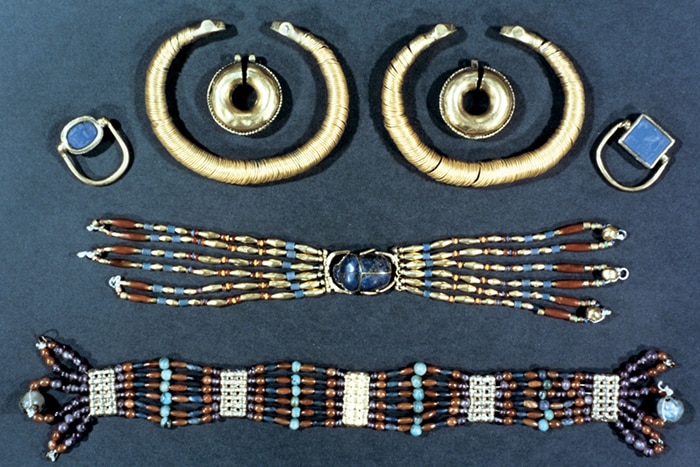Jewelry is the universal form of ornament. Jewelry made of shell, stone, and bone has survived since prehistoric times. It is possible that from the initial date. It was worn as a protection against life-threatening or as a sign of status or quality.
The discovery of how to work metal was an important stage. For the development of jewelry art in the ancient world. Over time, metallurgy became more sophisticated and decoration more complex.
Gold is a rare and highly prized material. It was conceal with the dead so that its owner could go into later life. Much archaeological jewelry is found from tombs and hoards.
Occasionally, as with Celtic Ireland gold collars, which have been found a fold in half. People seem to have followed a ritual to dispose of the jewelry.
This collar was found before 1783 in a bog in Shannongrove, Limerick, Ireland. We don’t know what it was used for, but most likely it was a formal collar. On the inside of the collar, there is a hole under each round terminal. The collar is usually resting on the chest and is held in place by a running chain between two holes and the back of the neck.
Where is the origin of jewelry?
It began when the first time man walked on the earth. Of course, the history of jewelry they wore in the old days was not made the way they are today.
The ancient people wore Jewelry of feathers, bones, shells, and colored stones. These were color pebbles and the gems have been praise and decorate for their beauty and durability.
Many types of jewelry made even today started as functional items. Pins and brooches arise from the clasps that hold the clothes together.
Rings and pendants were uses for early signs, symbols of identity, rank, and authority. The earliest known inventions history of jewelry date back to about 25,000 years ago. This simple necklace made out of fish bones was found in a cave in Monaco.
Taking care of your body can be just as important as the needs you take care of. Awareness of self-esteem and self-respect is not a concern, so being relevant also reflects the need.
What does Jewellery symbolize?
Jewelry helps to enhance one’s beauty. It is also a symbol of wealth, power, and status. For some, the history of jewelry is a work an art itself and for creative expression.
Some use jewelry as part of their traditions and culture. Although they may differ in terms of importance and relevance, they all play an important role.
In Indian culture pieces of jewelry play a symbolic role. They have their own ethnic and spiritual meaning, especially at weddings. The pieces of jewelry worn by the bride indicate that she will be part of her husband’s extend family.
She is part of a purification ritual as she becomes a part of the groom’s own extended family. The Indians value a wide range of bridal jewelry. The nuances of these jewelry ornaments are heavy, they play a big role in the family heritage and ornaments.
So before giving jewelry to the bride. The family usually makes sure they are heavier with a more pronounced design.
Different Jewelry materials and their importance
Jewelry holds deep importance in both tradition and religious beliefs. And these ornaments are create from precious stones and metals or a mixture of both.
Gold
Gold is the most popular metal for jewelry making. It is durable and does not wear out despite everyday usage. Gold is consider valuable to many Hindus. Hindus believe that gold has the power to touch anything.
It is also considered to be a symbol of power and wealth. In addition, it is also a symbol of good health, prosperity, and femininity.
Silver
Silver is also another metal that people wear frequently. It is standing next to the gold. In Hindu culture, gold is worn on the waist.
During this, you can wear silver till the waist down. The bangles, rings, anklets are generally made in silver. In tradition, silver represents protection from magic. Many people beliefs that silver stands for Moon or Luna.
It also symbolizes femininity and motherhood. It is believe to help fight negative emotions and improve one’s dreams.
Copper
Another commonly used metal is copper. Copper is often link to fertility and wealth. Being a highly conductive metal, it can be easily mix with other metal alloys to make jewelry more conductive and durable.
Copper jewelry symbolizes love, peace, and friendly relations with your loved ones. It can help people build better relationships with others.
Platinum
It is one of the most expensive metals that used in making lavish jewelry. This is easy to clean you can use mild soap and a soft cloth to restore its shine.
It is also known as hypoallergenic metal. Which is suitable for people suffering from allergies.
Diamond
Popular and one of the most luxury gemstones is uses in pieces of jewelry. This is usually related to marriage and engagement. In traditions, the diamond gives the wearer a sense of comfort.
This gemstone has supernatural powers which lead them to success. It is a symbol of purity, innocence, and eternal love.
Spiritual meaning of Jewelry?
The history of spiritual jewelry is always a way of celebrating the body as well as passing on the true essence of the universe. Contrary to the abstract, nihilistic belief, most of the world’s religions offer some form of protection to their followers in the form of small objects of jewelry.
Spiritual jewelry has played a significant role in this process. There has always been a strong need for tangible indications of a sensible size of what is imperfect as human beings, of what is intangible, or of what is difficult to define. Therefore, associating a small ornamental object (carrying one shape or another) with religious beliefs is not an uncommon practice around the world and throughout history.
Symbols and meanings of spiritual jewelry are always in abundance. The history and idea of making spiritual jewelry without meaning or spiritual substance are paradoxical. Therefore, no matter what sign it shows, its effect will certainly not be random, no matter how more or less obvious.
In ancient times, spiritual jewelry was intend to change the image of the person who wore it. It was believe that a person who wore it could only reach perfection and ultimate beauty that is specific to nature. Therefore, the people who wore it were not only beautiful in an earthly, perceptible way. But they were also safe from misfortune and destined for good fortune.
It was natural for nature to have an abundance of symbols. And then the architectural principles should finally be thought of as a form of eternal pursuit for the perfection and universal unity of the human body. Upon further inspection, you may agree that even in the present tense. Spiritual jewelry is intend to protect fortune and healing. In addition, it will attract attention to a particular part of the body and give it a wonderful, unique touch.
It’s also matters when spiritual jewelry is in the right position it can work miracles. For example, Necklaces is the most popular wearable jewelry, since it is very close to the heart and thus has a great power to influence the flow of emotions.
How was jewelry discovered?
History of Jewelry is one of the archeological artifacts. It known as the oldest jewelry with 100,000-year-old pearls made from Nassarius. The basic types of jewelry vary across cultures but most often they last a long time.
Jewelry includes decorative items worn for personal adornment. Such as rings, earrings, pendants, brooches, bracelets, necklaces, and cufflinks.
Jewelry can be add to the body or clothing. From a Western point of view, the term is limit to durable jewelry, with the exception of flowers for example.
Metals such as gold, often combined with gems, have been common materials for jewellery, for many centuries. But other materials such as shells and other plant materials can be uses.
The most common types of jewelry listed in European cultures have survived since ancient times. So other types, such as adornments for the nose or ankles, are much less common, important in other cultures.
Jewelry can be assemble from different materials. Gemstones and similar materials like coral, amber, pearl, shell, and precious metals have been uses extensively.
Jewelry in most cultures can be thought as a status or symbol for its physical attributes and its patterns. From hairpins to toe rings jewelry make to adorn almost every part of the body.
The proportions worn by adult males in modern European culture are lower than in other cultures.
Which culture created jewelry?
The history of jewelry begins in fifteen classifications based on age, style, geography, and aesthetic. These means jewelery items produced during prehistoric times.
The fifteenth classification includes avant garde jewelry. It often blends traditional and modern styles. This category of jewelry is the work of modern jewelry and is the result of simplicity, innovation, and experimentation.
The development of early jewelry history can be broadly divide into ancient civilizations. China is one of the oldest civilizations in the world. It began the production of jewelry in the Neolithic period. During the rise of the Yangshao and Longshan cultures.
The Chinese prefers metals like gold and silver as well as jade as gems in their jewelry designs. They produce large amounts of jewelry in different style by using many techniques. It has also influenced their style in Asian countries.
The 5,000-year history of Chinese jewelry is known for seven major jewelry-making techniques. Cloisonne, engraving, jade carving, filigree inlaying, precious metal threading, kingfisher feather ornamentation, and silver enamel.
What does Jewelry mean to different cultures?
In almost every culture and region of the world, men and women have been wearing jewelry for thousands of years. For most cultures jewelry give more importance.
It can be use as a status, symbol, wealth, religion, nobility, rank, job title and much more. There are some very compelling roles that jewelry has played across cultures throughout history.
Rings
No piece of jewelry is as popular or as meaningful as an engagement ring in America today.
Other pieces of jewelry, such as earrings, necklaces, bracelets can be a symbol of status and can express personal style. Engagement rings send a unique message to everyone who sees them.
They show the world that the woman who wears ring his married officially. Diamonds are the most popular stone for an engagement ring.
However alternative stones are becoming more popular. Engagement rings are growing in popularity across the globe.
Jade
It has been view in Chinese culture as a valuable stone for thousands of years. The jewelry can be more expensive than gold or silver.
The combination of beauty and durability of jade symbolizes the balance of yin and yang. The ancient Chinese also believed that wearing jade could ward off evil spirits and unhappiness.
Today, many Chinese families still have jade heirlooms which have been passes down from generation to generation.
Pearl
For thousands of years, pearl jewelry have played an important role in African culture. Some colors and patterns of pearls can be uses to indicate the membership of a particular tribe, to display status, and for religious ceremonies.
Many people wear beads for decoration or use them as currency. The pearl were make from natural materials, including shells, ivory, stones, and even ostrich eggs.
The color and style of the pearls tell about the marital status of others and also send a message about home, family and more.
Sapphires stones
Sapphires are often seen in jewelry made by Native Americans. But this is especially important for the Navajo, one of the largest tribes in the United States.
The colors sapphire are blue, green, white, and black. Relationships with the natural world due to the imitation of colors found in nature. Sapphire is believe to bring health, joy, and happiness.
It was also use as a status symbol among the tribes. The more pieces of jewelry will be worn and the larger the size the richer and more powerful the wearer will be.
Which country is famous for Jewelry?
When to come jewelry everyone is so excited to wear these ornaments and looks attractive. It is a unique way to express the jewelry in neck, fingers, ankle, and other part of body.
However, while many consider gold as a safe investment. Gold jewelry has become an important part of many cultures, often for reasons related to its value as an investment.
India and China have retained the top two positions in gold jewelery purchases. Jewelry consumption worldwide in the fourth quarter of 2019 accounted for nearly 46% of total gold demand.
In the fourth quarter of 2019, India and China accounted for 57% of global gold jewelery use. The demand for jewelry from China is more than a third of the global demand.
India
India is the world leader in the consumption of gold jewellery. In the second half of 2019, the use of jewelery in India declined by 32% per annum.
A quarter of the demand for gold jewelery for the first half of the year was met through the exchange of old jewelery.
China
China is the world’s second largest consumer of gold jewelry. Demand for jewelry-related gold for China declined in 2019. Gold demand declined 8.6% for the full year 2019, while the year-on-year gold demand declined by 9.7% in the second half of 2019.
Decline in consumer spending has led to a decline in the consumption of gold jewelry in China. The jewelry industry in the country consumes more than 65% of the gold.
America
The U.S. ranked third for gold consumption in the 2019 quarter, still better than China and India.
Rising gold prices have slowed consumption in the United States.
Germany
Germany is the fifth largest consumer of gold jewelry in Europe after Turkey. In the fourth quarter of 2019, the country consumed 5.4 tonnes.
However, in view of rising prices and economic slowdown. The demand for gold in the country has declined on a year-on-year basis. Key reasons for the decline include the shift from high-end jewelry to technology and experience buying.
Read More
Evolution of Saree how it changed from ancient to modern
Difference between Traditional and Modern Fashion
The Modification of Street style fashion 2021




